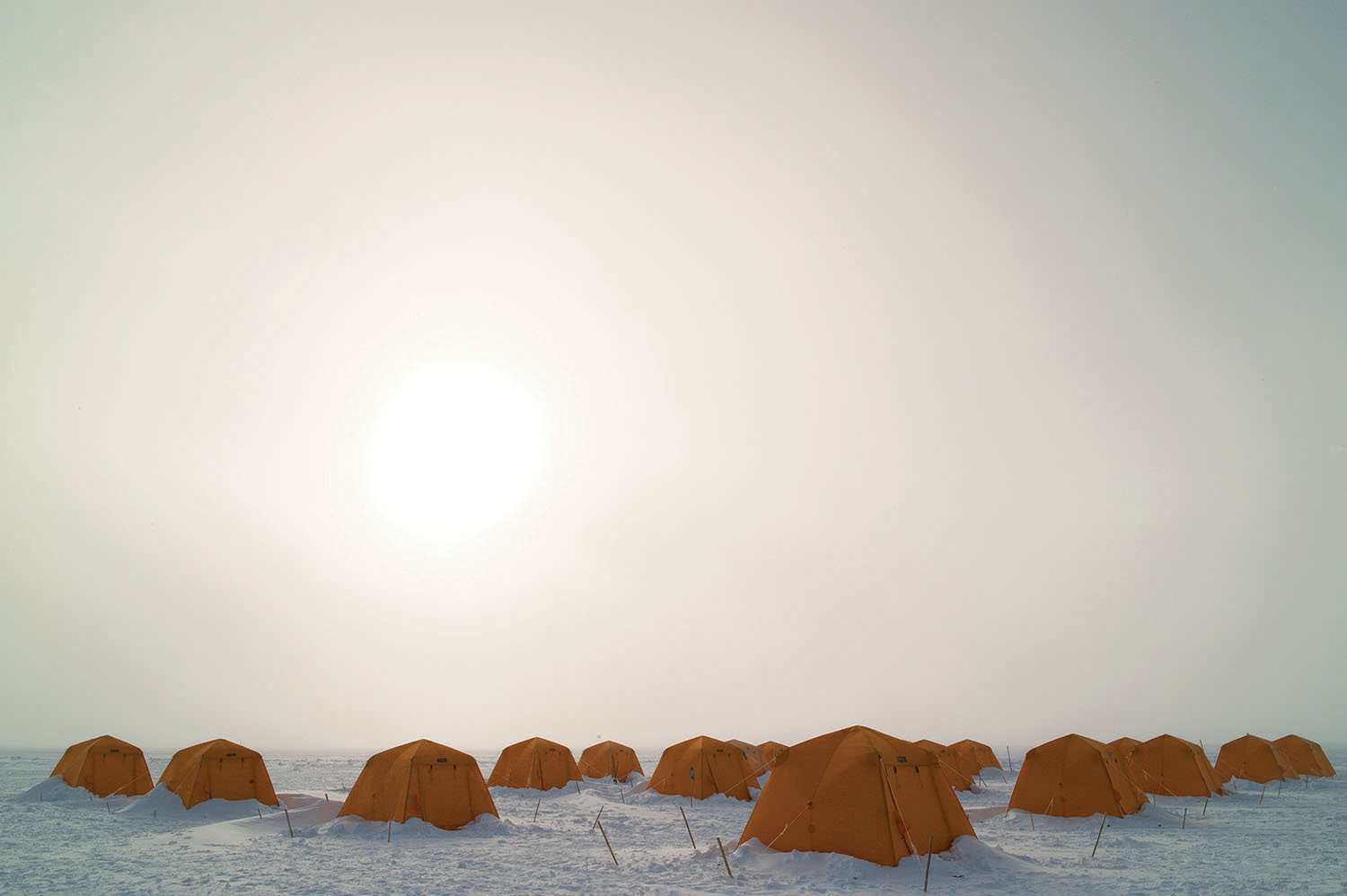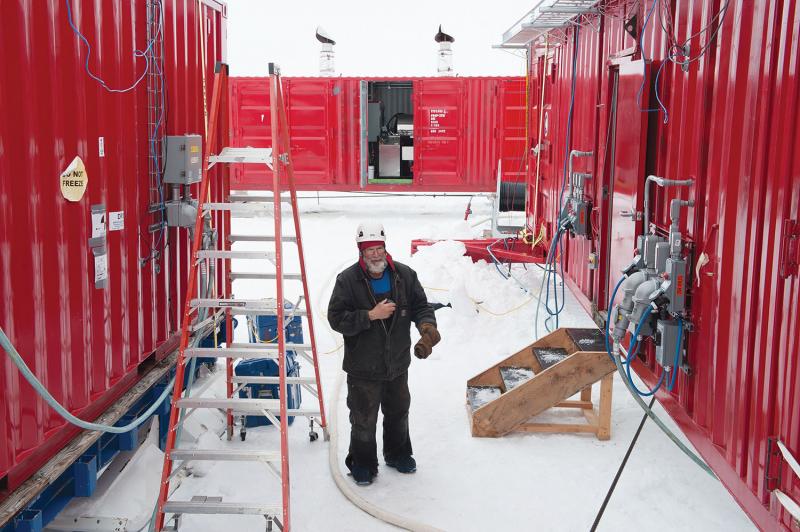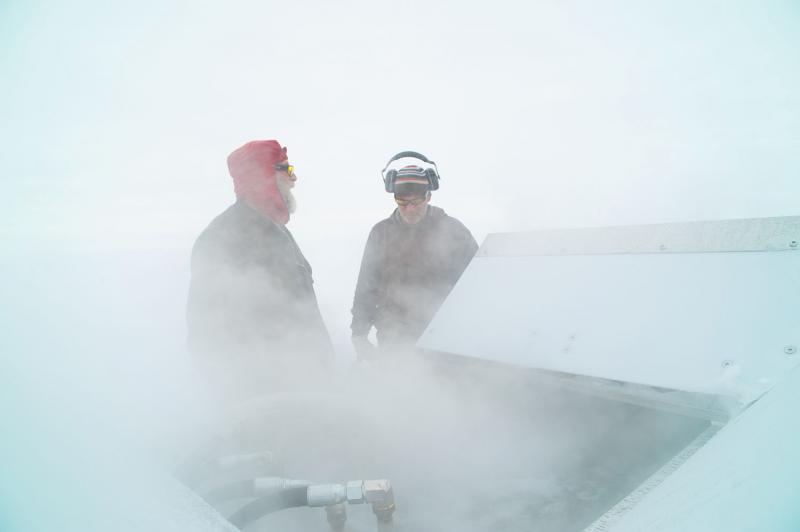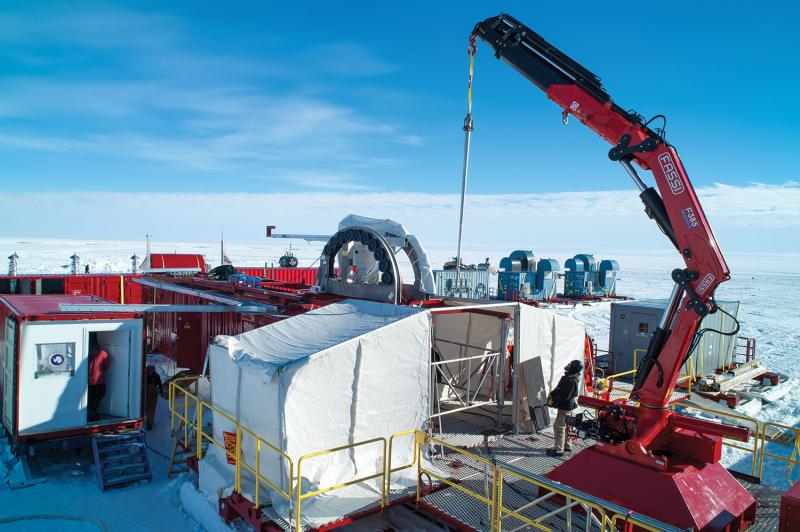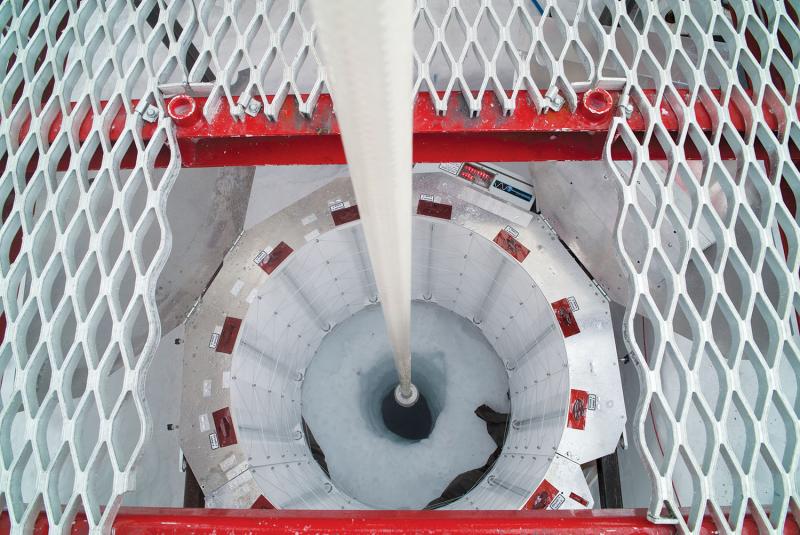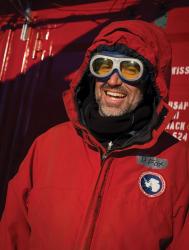On a late day in January 2013, toward the end of the Antarctic summer on a remote stretch of the West Antarctic Ice Sheet, Dennis Duling and his six crewmates were busy crawling and climbing over a series of shipping containers lined up on the snow. They were performing last-minute repairs on their machine, a custom-built monstrosity called a hot-water drill, which they had transported here to provide a much sought-after service: to melt a hole—two feet wide and half a mile deep—into the West Antarctic Ice Sheet so scientists could get their first-ever direct view of the world beneath the ice. If this effort succeeded, it would mark a milestone of scientific exploration, on par with landing a probe for the first time on Mars.
Two dozen or so scientists had gathered at the field camp where the drilling would take place, eagerly awaiting the narrow portal to be opened into this subglacial underworld. Directly below them lay Lake Whillans, a sunless body of water that had not seen daylight in at least 100,000 years. The scientists were hoping for insights into the physics of the overlying ice sheet, and about what kind of life might exist beneath it—the same kind of life that might, by extension, lurk inside the ice-covered moons of Jupiter and Saturn. The success or failure of the $10 million project, funded by the National Science Foundation, rested on the shoulders of Duling’s team of seven ice drillers.
He and his crew spent two years building the drill back in Lincoln, Nebraska, on a shoestring budget—stitching it together from a menagerie of farm, factory, and other equipment never meant to commingle in a single entity. All told, it weighed half a million pounds. Its various components filled five massive shipping containers and three gigantic sleds, lined up and connected end to end by electric cables and hoses: a metallic, segmented beast sprawling across an acre of snow.
Duling, who has a bushy white beard, somber blue eyes, and thick hands calloused from decades of labor, hails from a family corn farm in central Nebraska. He led me on a tour of the drill—up and through and under, like walking through the belly of a carnival ride, pointing here and there to give a kind of genealogy of its parts. “That’s a dairy storage tank,” he said as he pointed toward a truck-sized cylinder overhead. “A stirring tank, like out of a cheese factory. I bought it used from Ullmer’s Dairy in Pulaski, Wisconsin.”
Duling, sixty-one, spent much of his life in Nebraska dynamiting old buildings and bridges, digging graves, salvaging railroad track, and repairing everything from harvest combines to Army howitzers. He wore a red mukluk with flaps over his ears, mirrored sunglasses, and an overall jacket with a strip of silver tape running down the back, slightly off-center—a practical modification that allowed him to grab the right jacket when it was lost in a pile.
We walked across the scalloped, wind-sculpted snow and up several steps to the door of one of his shipping containers mounted on four massive metal skis, each ski larger than a canoe. The container held several shiny metal boxes resembling propane grills: power-washers normally used to clean semis, repurposed here to heat water for the drill. Inside another container, outfitted with massive motors for lowering the drill nozzle into the hole, he showed off a chest freezer the size of a washing machine, which was being used as a snow-proof case for circuit boards. “We got it out of the dump,” he said, proud of his thriftiness. “It beats building one.” Overhead, he gestured to a row of electric boxes that drove various pumps and motors, adding: “A Kellogg’s cereal factory would use a lot of the same stuff.”
On the day that drilling began, a brisk breeze blew through camp—propelled by a current of dense frigid air pouring off the high Polar Plateau, sixty miles south. Wisps of white, powdery spindrift slithered over the ground. At the head of the machine, two truck-sized generators started to roar, burning jet fuel to crank out nearly half a million watts of electricity. The drill’s circulatory system churned to life, and what was mechanical began to seem almost biological: Water coursed from one shipping container to the next through arteries of reinforced Kevlar hose as thick as a man’s wrist. In the first container, powerful ultraviolet lamps sterilized the water; filters removed outside material that might contaminate the pristine Lake Whillans, if and when the drill reached it. In the next two containers, Duling’s prized fleet of power-washers pressurized and heated the water to near boiling. The hot, clean water then passed into the next container, gushing into another Kevlar hose, more than half a mile long, coiled around a mechanized spool as wide as a city bus. Despite its vast scale, the drill functioned on a surprisingly simple principle, akin to peeing into a snow drift: By forcing hot water into the ice, you can gradually create a hole.
The cobbled-together drill was emphatically low-tech, because Antarctica demands low-tech; the harsh environment tends to break newfangled, complex machines. And so this crew of seven—Duling, Daren Blythe, Justin Burnett, Chad Carpenter, Dar Gibson, Jeff Lemery, and Graham Roberts—functioned collectively as the drill’s nervous system. Their jobs were both precise and improvisational; they were constantly crawling and climbing, ready with a wrench or screwdriver, alert for a rattle that might portend a broken valve, or a puddle of water indicating that a pipe fitting had vibrated loose. With radios clipped to their pockets, they stayed in constant touch across the machine’s far-flung appendages as the drilling began.
Roberts, in the power-washer container, called into his radio: “I’m going to send a bunch of water your way,” he said, alerting Gibson, who was standing near a tank outside, just a few yards away. Roberts then cranked a valve and diverted a surge of hot water from the main drill hose to the tank. Gibson began shoveling snow into its open, steaming top.
Burnett called over the radio: “Dairy tank is 40 percent full, 31 degrees Celsius.” At twenty-five, Burnett was the youngest of the ice drillers. He sat in a makeshift control room shoehorned inside a container next to the spool. The spool began to turn, unreeling the hose, feeding it out over a series of pulleys and down into a hole in the ice. As the hot water shot from the hose’s nozzle, the ice melted even further, the spool hummed, and the hole deepened, inching closer to the grail.
The human brain’s primitive functions are often overlooked—the moment-to-moment management of physiology and oxygen levels, the shifting of blood flow and warmth from one organ to another, the continuous adjustment of minuscule muscles that control the width and elasticity of individual arteries. Yet these functions, critical to life, occupy the collective chatter of more than 100 million nerve cells in the human brainstem. Only by isolating these life and death matters from the realm of consciousness and thought, far down in its primitive stem, does the human brain ensure that they are managed without interruption.
The ice drillers had achieved something similar, something deceptively challenging: As a unit, they had claimed control of a machine’s physiology. Their cohesiveness would be tested as they tried to coax and steer their drill deeper into the ice sheet. And the truth was that poor weather, delayed flights, and mechanical glitches meant they were already behind schedule. The Antarctic summer was drawing to a close, with temperatures falling. Tapping the lake, if it happened at all, would take several more days. Duling and the crew had received firm orders from managers at the National Science Foundation, which oversaw the expedition, to stop drilling on January 31, just a week away, and to pull out of the field camp several days after that.
The smaller of the drill’s two hose reels wobbled and groaned as it turned. “The axle doesn’t fit right, but it works,” Duling said, adding that you’ve just got to “grind a few things off” to make it turn a little more smoothly, or unbolt it and “just go around it” for the sake of expediency.
Anything to avoid losing more time.
The drill crew’s story begins in the deep heart of Antarctica, past where the Transantarctic Mountains cut a jagged procession marking the transition from the ice sheet to the high Polar Plateau in the south. South Pole Station, built on this plateau, sits 9,300 feet above sea level, where the air is more rarefied than one might expect, even at this elevation—a result of Earth’s rotation, which causes the atmosphere to bulge at the equator and stretch thin over the poles.
Working at South Pole Station, often known simply as Pole, was how most of the ice-drilling team got to know Antarctica. Duling arrived in 1999, after a brief stint in Greenland, where he led a crew tasked with lifting a building buried under years of snowfall. Only the point of its roof was visible when Duling arrived. Over the course of six weeks, the crew managed to excavate the building’s foundation, insert a makeshift jack beneath it, and raise it thirteen feet to the surface.
Work on the ice was radically different from the kind of work Duling had known until then—though his earlier work life had included plenty of variety. By age ten, he was driving the tractor on his family’s Nebraska farm, disking and plowing fields so that his father could plant wheat and corn. After high school, Duling graded roads in Lincoln, worked several years in the local Goodyear factory, manufacturing rubber belts and hoses, then worked as a contractor for farmers or small municipalities installing plumbing and water-well systems and dynamiting old bridges or clogged irrigation ditches. He loved the blasting jobs, spending hours calculating the size and arrangement of charges, then setting them to detonate one-thousandth of a second apart so the individual blasts would muffle one another’s sound.
The experience in Greenland appealed to Duling’s taste for variety, and for not having a boss breathing down his neck, so he took another job on the ice almost immediately—at Pole, in time for the Antarctic summer, November 1999 to February 2000. He joined a hot-water drilling crew there to melt six holes, each 6,000 feet deep, into the ice—a project known as AMANDA. Scientific instruments were then inserted into the holes to detect cosmic neutrino particles, which Swiss-cheese through the Earth trillions of times per second.
At the time, South Pole Station consisted of several modular buildings and clusters of cargo pallets, all enclosed within a geodesic dome of Plexiglas and steel lattice—a human terrarium. Sunlight filtered wanly through the dome’s arched ceiling, and a circular wall of snow, monolithic as sedimentary stone, pressed in on all sides, rising as high as the roofs of the buildings inside. People entered and exited the dome through a tunnel in the snow.
Darren Blythe, another drilling crew member, arrived at Pole the same year as Duling (though he doesn’t recall meeting Duling that year). Blythe was unlucky to arrive at Pole already weakened by a nasty cold. The day he landed, he hefted his bags across the snow to his dorm assignment 400 yards outside the dome, a metal “Hypertat” hut with eight rooms adjoining a central hallway. He opened the door—a plastic accordion curtain hanging inches off the floor, with no real privacy—and saw his room, the size of a walk-in closet. He collapsed in bed, still in his jacket, reeling with a crushing headache—“pretty discouraged,” he admits, “almost crying.” He slept fitfully, waking up gasping in the thin air, a classic symptom of altitude sickness.
Before even embarking on the trip, Blythe had already signed on to stay through the winter, a stint of thirteen months total. He was one of fifty or so people who spent the sunless winter there that year. That season was a “legendarily bad” one, with such traumas as the death from methanol poisoning of a thirty-two-year-old astrophysicist and the isolation and grief of the fiancée he left behind, who was also wintering at Pole. Blythe is quick to say that he wouldn’t want to relive those dark days, but he acknowledges that the experience somehow intensified what was already something profoundly meaningful. Antarctica “changed me fundamentally, in terms of how I viewed life back in society,” he told me. “It gives you a certain perspective when you sequester yourself in a place like that, with a small group of people.”
Blythe’s working life before Antarctica was an odd mishmash of blue- and white-collar jobs—though driven by an unquenched search for fulfillment that differed from Duling’s opportunistic exploration of the world. After graduating with a degree in physics from the University of Virginia, he worked as a carpenter building houses for nine months before he was hired by the NASA Goddard Space Flight Center—the surprise result of a résumé he’d mailed, and forgotten, the year before. He worked at NASA as a flight controller for the Hubble Telescope, a job that sounds “a lot more glamorous than it was”—eight-hour shifts in a front of a computer screen, monitoring the satellite’s vital signs, the voltages and electrical currents deep in its circuit boards. “I started having this feeling,” he says, “that the typical path that the typical American white male takes through life was not necessarily what I wanted.”
Blythe left NASA, earned a masters in physics at Clemson, then found work with the defense contractor EG&G. This landed him, once again, in the very sort of office park- and suburb-life that he’d been trying to avoid.
Blythe’s time at Pole provided some surprising insights into what it was that he did want. Each morning he awoke, threw on his jacket, and began his quarter-mile walk to the dome under dim starlight. As the temperature dropped to -70, -80, and then -90 degrees Fahrenheit, the sound of his boots grew squeaky, like Styrofoam, on the hardening snow. His breaths whooshed into the cold air. On some days he’d watch the green-and-white-curtained light of the Aurora Australis dance above him, “the sky swirling from horizon to horizon.” Other days, he could see constellations of the southern hemisphere—the galactic center of the Milky Way, or the faint fleeting wisps of the Magellanic Clouds.
But rather than these moments of staggering beauty in the Antarctic winter, it was the daily repetition of mundane interactions that Blythe found transformative. In the ad hoc village thrown together inside the dome, he says, “the daily taking meals with others forces you to connect with people that you’re not usually forced to connect with in the real world.” Mealtime conversations led to relationships with people of disparate backgrounds—the station plumber, the cooks, firefighters. The irony of a restricted population was that the network of relationships actually expanded. This was true not only within South Pole Station, but also across the sparse constellation of humanity sprinkled and isolated in tiny enclaves across the entire Antarctic continent through winter. Each Saturday night, Blythe and a handful of others gathered in the communications office at Pole for the ritual of “radio-darts”: a game of darts shared, via staticky radio conversation, with participants hundreds of miles away at McMurdo Station, at New Zealand’s Scott Station, and sometimes at Australia’s Casey Station.
Scientists have long studied the psychology of small groups isolated through winter in Antarctica or the high Arctic, hoping to gain insight into the social challenges that would face people in comparable situations, such as long-term space flights to Mars or distant stars. Ironically, some of these studies suggest that social stress and conflict are highest during the beginning and end of a year-long stint, but that stress actually declines during the dark mid-winter as relationships stabilize amid an expectation of no disturbance from the outside world. At Pole, Blythe says, “I found a sense of community that I had been looking for all my life, but didn’t know I was looking for”—profoundly different from the workaday, middle-class world in which he was raised, in which the daily dispersion of family members to places of work and school yielded fewer, weaker connections. By contrast, that first winter at Pole was “like having a family, maybe analogous to what human society was thousands of years ago, when it was very much more tribal.”
For Blythe and Duling, then, the seasons differed but the pull was the same: Antarctica kept calling both men back. Duling took a year off after his first summer on the ice, then returned three summers in a row, working on a dynamiting crew that maintained roads at McMurdo Station, and blasted eight-foot-thick sea ice out of the station’s shipping harbor.
Then, in November 2004, Duling returned to Pole for a more ambitious drilling project, known as IceCube. Its goal, like that of AMANDA multiplied, was to melt eighty-six holes a mile and a half into the ice, so that scientific instruments could be lowered and left to measure the faint signals of cosmic neutrinos. IceCube occupied Duling for seven summers, from 2004 to 2011. Hot-water drilling was still in its infancy, and the team was stretched dangerously thin that first year. The drilling machine, built on an unprecedented scale, constantly broke down.
Progress on IceCube improved in later seasons—though not without the occasional obstacle. During the 2008–2009 season, by which time Duling had been promoted to a shift leader, the crew repeatedly found their drilling progress blocked by wood boards, parachute canvas, and other objects thirty feet down—old forgotten trash buried by decades of snowfall. Once the drill came back up with part of a frozen pork chop stuck to it; another time it emerged bearing a postage stamp, dated 1967.
Determined to break the impasse, Duling improvised a flamethrower to burn through the trash, fashioned out of a pump, an air compressor, and some jet fuel. The hole roared, and light from the flames danced off its icy walls “like something in a movie,” Duling recalled with satisfaction. “Like a hellhole.”
At Pole, the future Lake Whillans drilling crew began to coalesce. Blythe joined IceCube as a driller in 2005, as did Gibson. They and Duling worked together during off seasons after that, designing and building drill parts at IceCube’s home base at the University of Wisconsin in Madison. In 2009, Blythe left IceCube, a year before the project was slated to end, shifting to another Antarctic project, ANDRILL, because its home base at the Univesity of Nebraska got him closer to where his fiancée, Jill Fox, was living. Two years later, in early 2011, the director of ANDRILL, Frank Rack, bid for another project: to design and build the machine that would be used to drill into the gigantic ice sheet covering Lake Whillans.
It was luck that led Rack to lure two of Blythe’s old IceCube crewmates—Duling and Gibson—to join the Lake Whillans project. The men were unencumbered by relationships and could relocate from Madison to Lincoln without a second thought. With Blythe, Duling, and Gibson on board, the team was set to build a monster of a machine under a deadline of only two years. The project was already a year behind—the result of another team already having failed to build it in Madison.
By June 2012 it became clear that the job was too big for the three-man team, and Duling and Rack brought in four others to help finish construction: Chad Carpenter, who’d worked as an electrician on IceCube; driller Graham Roberts; and Jeff Lemery and Justin Burnett, drillers who just happened to contact Rack looking for work. The new crew members packed up their lives in cities across the country and relocated to Nebraska for the final push.
The mammoth reel container, all 75,000 pounds of it, was finished in mid-September 2012. It was hoisted onto a tractor-trailer truck, then hauled all the way to Port Hueneme, in California. From there it rode a container ship to New Zealand, where it was winched up a ramp and into the back hatch of a C-17 Globemaster military transporter (its weight and dimensions had been painstakingly calibrated to fit inside the plane). The C-17 touched down with the reel container on November 13, on a slab of floating sea ice thirty feet thick—the airstrip for McMurdo Station.
The drillers had already gotten to McMurdo in October, and there they assembled the eight segments of their machine as it arrived piecemeal on the ice. They spent a month testing the drill near McMurdo, then began breaking it down—again—for the final leg of the journey, a 600-mile sled trip to the field camp. The drill site was much more isolated than IceCube had been, with little opportunity to bring in spare parts or evacuate an injured worker. As Duling put it, there was “no room for error.”
In Antarctica, even machines must resist the slide into hypothermia. Extreme cold can stiffen and break the delicate wires on circuit boards; it can cause laptop computers to run at one hundredth their normal speeds, as the hard drives spin sluggishly; it can turn engine oil into gooey syrup, meaning that even powerful cargo planes must have their engines slowly warmed with massive hot-air blowers before they can be started. But the dangers are even greater for machines, like the drill, that circulate water through their metallic organs. If the drill shuts down and the water stops flowing, the crew must work quickly to restore flow before the water begins to freeze in the hoses. Metal fittings will also freeze, causing the mechanical equivalent of a blood clot to form, bringing its circulation to a halt. “It’s amazing how strong ice is,” Gibson told me. “You can be pushing a thousand PSI against it, and if you’ve got a little ice plug, that’s going to stop everything.” Even breaking the ice clot free has its consequences, Blythe added, since it could “move down the hose and get caught at a bend or something. You have no clue where the blockage is.” In the worst case, drillers must race to drain water from the entire drill hose; if thousands of feet of hose froze in a remote place like this, the expedition would be over.
On January 23, toward the end of its first day of operation, the drill suddenly fell silent. Gibson, Blythe, and Carpenter ran out of the control room to search for the cause. They rifled frantically through the reel container, opening and closing breaker boxes, examining wires and switches. But they had no way to home in on it.
Twice the machine was restarted, and twice it lost power. Carpenter, the electrician, finally located the culprit: a diminutive, twenty-four-volt power supply, about the size of a pocket dictionary, that had fried. He replaced it with one that was hurriedly yanked out of another shipping container.
Gibson sat at the computer monitor, waiting nervously for the drill’s sensors to come back on. After it had been restarted, he continued to eye the screen with suspicion, not trusting the readings of the flow sensors, since they could have been damaged when the drill shut down. “It’s always like this, something critical goes out,” he said. “Something so small—but it stops the whole operation.” He spoke to the drillers through the radio: “Let’s go into a normal drill-valving situation and see if things sort themselves out.”
As the drill inched downward, sometime after midnight Burnett, Gibson, and Blythe gathered for a respite in the control room. The space was cluttered with Carhartt jackets, goggles, gloves, plyers. A bottle of Ice Hole schnapps stood in a corner, reserved for celebration. They soon found themselves talking about one another’s dreams. Burnett, on his first-ever trip to Antarctica, seemed amused by the fact that he hadn’t had any dreams set there since he’d arrived three months ago.
“You will,” Blythe said. “As soon as you go home.” After his first winter at the South Pole, Blythe said, he “dreamed about Antarctica for six months straight.”
Gibson agreed. “I still have Antarctic dreams, mostly about my first winter” at South Pole thirteen years ago. “That classic dream that people told me about—you walk [outside] and instead of snow it’s all grass.”
“Grass and trees and power lines,” Blythe said. “I’d see those big power-line towers marching off, over the hills, into the horizon.” For now, the drill hummed along uneventfully—its water temperature 160 degrees Fahrenheit, the Ullmer’s tank 48 percent full.
Antarctica’s ice sheet is not at all the static crust most people think it is; it’s constantly moving and shifting. The ice, under pressure, behaves as a fluid, a billion times more viscous than honey. Drill a hole into it and it either refreezes or actually oozes closed, the thick fluid squeezing inward until the hole pinches shut. “Only the paranoid survive,” said Slawek Tulaczyk, a glaciologist from the University of California in Santa Cruz, who helped plan the drilling project, calculating and recalculating the pressures and temperatures at which the borehole might succumb. He had come to Lake Whillans to see how well those calculations would hold up.
To drill into this sluggish molasses is to grope into the unknown, trusting that gravity will draw the hole downward. The extreme cold and pressure found deep in the hole have a way breaking delicate electronics, flooding them with water or stiffening and fracturing tiny wires on a circuit board. So the Lake Whillans drillers were forced to drill without a camera, without direct visual knowledge of what was happening thousands of feet below. Instead, they relied on surrogate senses of touch and pressure as proxy measurements. An odometer counted the revolutions of the hose spool, which allowed them to estimate the length of hose fed down the hole and thus the depth of the hole itself.
At around midnight on January 26, with the drill 2,565 feet below the surface, the water level in the hole appeared to drop a few feet. It suggested that water was leaking into an empty space beneath the ice—in other words, that the drill had broken through into the lake. The team pulled up the drill and lowered a camera, gathering in the control room to watch the live video feed, and hopefully confirm what had happened. The camera revealed that at 2,300 feet, the borehole had suddenly branched: As the drill nozzle was raised and lowered again and again to widen the hole during the previous hours, it had apparently strayed to the side, melting an unintended second passage. One of those passages may or may not have led to the lake, but the camera had gone as far as it could go, blocked by the twisted geometry of the branch.
“I’m going to erase that whole section of the hole and turn it into liquid,” Duling said testily. Scientists who had crowded into the control room to watch the video and hopefully see the lake slowly filtered out of the room, disappointed. The crew raised the camera and lowered the drill nozzle to the depth of where the hole branched in two. They then began pumping thousands of gallons of hot water to widen the hole and merge the two branches.
That evening, the video camera was lowered a second time. The drillers again crowded into the control room to watch. There was a collective gasp as the same branch at 2,300 feet came into view: Somehow it had survived the day-long attempt to melt it.
Duling left the control room in disgust. Outside, on the drill rig, John Priscu and Ken Mankoff, two of the research scientists, tugged back and forth on the dangling camera cable—a desperate attempt to plunk the camera into the larger branch. If it worked, they might at least be able to confirm that the branch led to the lake. It seemed a long shot. Priscu and Mankoff may as well have been blindfolded, since the intervening half mile of cable introduced an incomprehensible time delay between their own heaves and yanks, there on the drill platform, and the motions of the camera far below as it bounced, turned, and banged against the sides of the hole. When the camera finally did drop into the deeper hole, the control room erupted in cheers.
They lowered the camera another forty feet into unexplored territory. The new hole expanded, contracted, then widened again. The room was silent. Then the camera stopped moving. A second or two passed before they understood what they were seeing: The camera had come to rest on a floor of ice. The hole had dead-ended. The lake itself was nowhere in sight.
At 8 p.m., the day shift began melting snow for another push. A short distance away in the mess tent, Duling conferred with Priscu and Tulaczyk. The mood was somber. “When you come down here, you get your nose bloodied,” Duling told the scientists with a weary sigh. “It’s okay. We can handle it.”
The next day, all seven drillers crammed into the control room again to watch as the drill slowly churned through the ice—2,595 feet…2,596 feet—toward where the lake was predicted to be. At 2,629 feet, the pressure meter spiked. The surface of the water jumped fifty feet as water gushed from the lake into the bottom of the hole.
“Let’s park the drill there for fifteen or twenty minutes,” Duling said, so that they could widen the hole and ensure that the job was done. Vessels were lowered into the lake, yielding gallons of honey-colored water—a thick mineral broth teeming with microscopic life, which would later be shown to contain as many microbial cells per teaspoon as are found in most of the world’s ocean water.
With the drill on standby, Graham Roberts diverted some of its hot water into a makeshift shower stall beside the melt tank, constructed out of cargo pallets, tarps, and a shower head scavenged from a dumpster in McMurdo. Frequent calls went out over the radio that “Bath Ops” were open for the next user. Two dozen people would take advantage of this over the next couple of days, emerging with a conspicuous glow of combed hair, despite the chill of drying off in 20-degree-Fahrenheit air.
The bottle of schnapps, along with several other bottles of liquor, still hadn’t been touched. “I want to celebrate,” Gibson said. “But I want all of the instruments out of the hole before I do that.” Some instruments were getting hung up in the lower reaches of the hole, suggesting that it was narrowing faster than the crew had expected. And when the scientists tried to retrieve sediments from the lake bottom, the mud-grabber came back clean, mudless, frozen shut. The drillers spent another eight hours running the hose back down the hole, pumping in hot water to widen it.
Late that day, the mud-grabber was lowered again and plunged into the lake bottom. This time, it emerged caked in dark-chocolate goop, which dripped, spattering onto the snow around the platform, as the device was unclipped from a cable and carried into a laboratory. The mud was gelatinous and gleaming, but was as abrasive to the touch as wet cement, full of glacially pulverized stone fragments. Jeremy Lucke, the crane operator, dipped his fingers into it, as did several graduate students on the science team, painting lines and whiskers on their faces. The mud quickly hardened in the dry Antarctic air, turning grayish and crusty. Most of the tension around camp had evaporated. Finally, after their overnight shift ended, a few of the drillers allowed themselves to relax with a bottle of whiskey in the dining tent.
The next day, the science team lowered a narrow metal cylinder down the hole, packed with chemistry instruments to analyze the water. As it descended, its downward-looking video camera revealed a scene reminiscent of driving with headlights into a blizzard: tiny needles of frazil ice—formed by super-cooled water at the bottom of the hole—rising to the top, lifted by their own buoyancy. The ice sheet was already beginning to close.
In the months after the researchers returned home with mud and water samples from Lake Whillans, they would go on to identify at least 4,000 types of microbes inhabiting the lake. In the absence of sunlight, these microorganisms subsist by gnawing on iron and sulfur minerals, and by burning simple fuels like ammonium and methane that filter up from the mud. The lake water itself is surprisingly temperate, warmed by geothermal heat seeping from deep in the Earth to a temperature of 31 degrees Fahrenheit, warmer than the coastal ocean waters 600 miles to the north. Lake Whillans would turn out to provide the best view, to date, of what kind of life might exist in deep oceans, buried beneath miles of ice, in frozen moons like Europa and Enceladus. As Priscu put it, “This is a new frontier. I think we need ten years of this before we really understand it.”
Duling and his crew returned to West Antarctica in January 2015 to drill again, this time 100 miles downstream of Lake Whillans, where an isolated tongue of ocean water reaches 500 miles inland, under a slab of floating ice as large as France and in many places more than 2,000 feet thick. The hole was drilled without drama, finished a week early.
Justin Burnett came this time not as a driller, but as a graduate student from the University of Nebraska. He had helped to build a small remote-controlled submarine, and helped pilot it under the ice, its cameras piping back images of fish and other sea animals that neither the scientists nor the drillers had expected to see in these dark, nutrient-poor waters.
That season marked Blythe’s tenth trip to the ice—and likely his last one for some time. When the season began, he had left his wife at home with their first child, Audrey, who was then two months old. By the time Blythe saw Audrey again at the Lincoln Airport, she was an expressive, giggly six-month-old. As Blythe emerged from the security gate, his daughter stopped her gurgling and stared at him with a wide expression—a moment of recognition, perhaps—and reached out to touch his face. He decided to stay home after that, a choice made with mixed emotions, feeling pulled in opposite directions by two families, in two hemispheres.
Ironically, his greatest desire to return to Antarctica stemmed from Audrey, and the inevitable search for meaning that she would one day face, just as he had. “Maybe I’ve transferred it onto my daughter now,” he said. He paused, then added: “I kind of would have liked to have her grow up seeing me do stuff on the ice. I would just want her to know that there’s a wider world available to her.”


